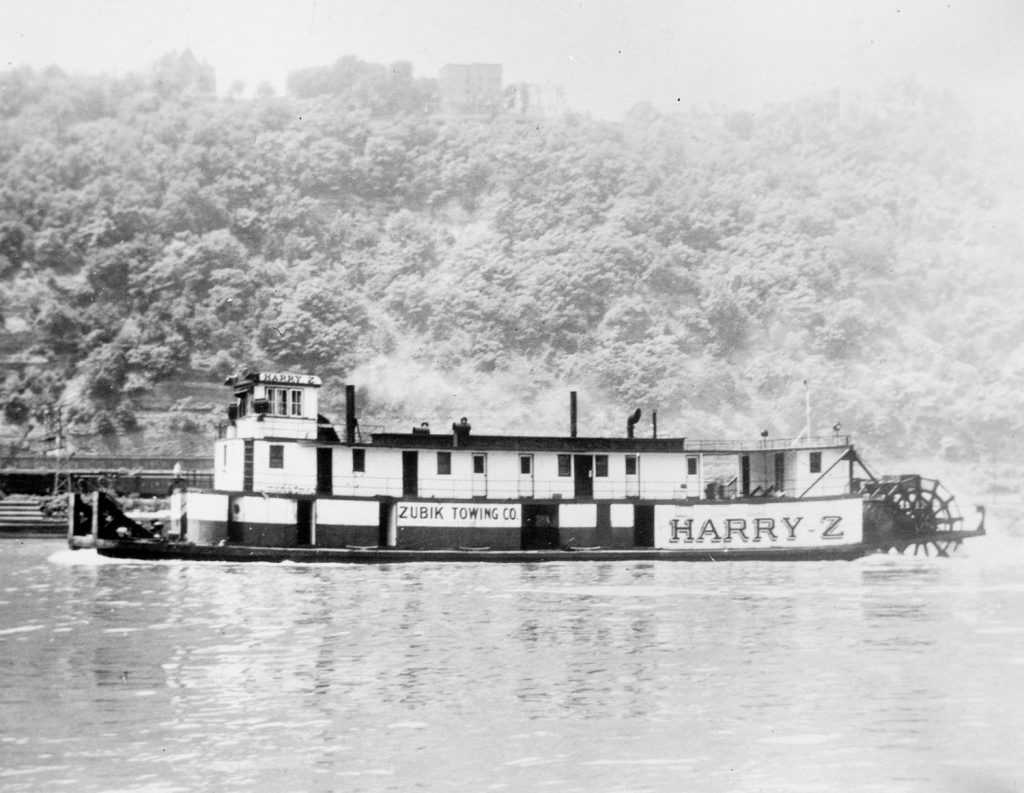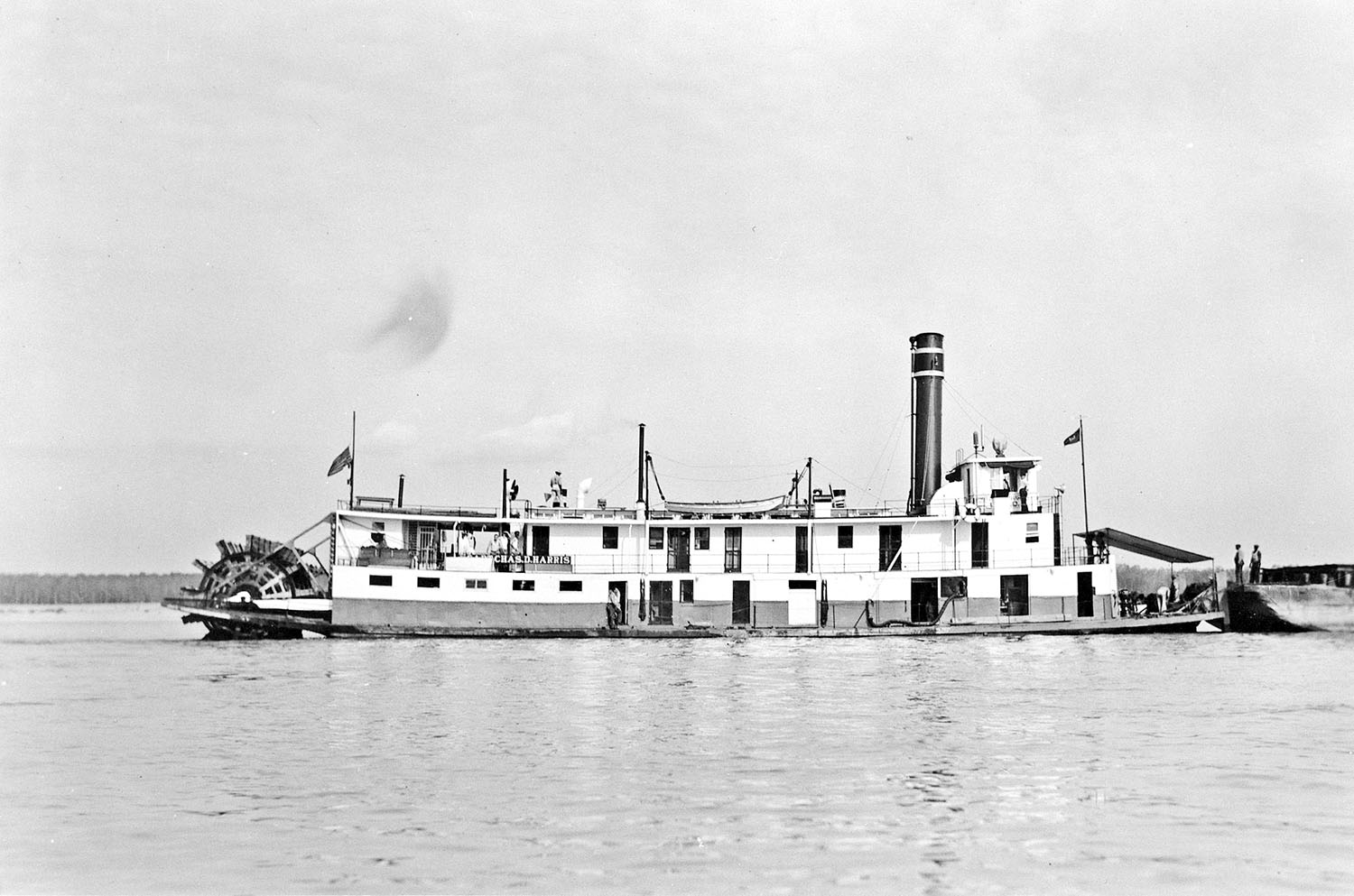In 1921, the Eichleay Contracting Company, Hays, Pa., built a sternwheel steam towboat for the U.S. Engineer Department. This was the first towboat built by Eichleay, and it was built with a steel hull measuring 116 by 29 by 5.5 feet, with overall dimensions of 132 feet. The boat had compound engines 12’s, 28’s – 5 foot stroke and one boiler. Way’s Steam Towboat Directory lists the name as “Capt. Charles D. Harris”; however, some photos of it in operation for the Engineer Department show the name displayed as “Captain Chas. D. Harris.”
The boat did not look like a traditional Mississippi-style steam towboat, but more like one found on the West Coast or in Alaska. The upper cabin extended forward almost as far as the main cabin, and there was one tall smokestack located behind the pilothouse. There were no exterior stairways in evidence leading from the upper cabin to the roof and pilothouse, but there did appear to be an enclosed one. Vertical ladders were located at each side of the forward end of the upper cabin. The Harris was assigned to the Memphis District.
In 1940, the Captain Chas. D. Harris was sold at a public sale to Charles Zubik, Pittsburgh. The machinery had been removed by the Engineers prior to the sale, and it was placed on the snagboat Arkansas II, with the hull built at Leetsdale, Pa., by Bethlehem Steel Company in 1940 and the boat completed at West Memphis, Ark. The Arkansas II would operate until 1966, and after dismantling, one of the engines would later be set up in the Mud Island River Museum at Memphis.
Zubik converted the Harris to diesel power and renamed it Harry Z. It then had a Fairbanks Morse engine of 450 hp. coupled to a center gear driving a split sternwheel. The tall smokestack was gone, replaced by one no taller than the roof of the pilothouse, most likely for clearing the low bridges in the Pittsburgh pools. Otherwise, the boat retained its original appearance.
The Harry Z was a familiar sight in the Pittsburgh area for many years. A color photo of it appeared on the front cover of the January 1954 issue of Waterways magazine. Though in the distance, the profile of it is unmistakable. Waterways was a competitor to The Waterways Journal and had begun as National Waterways. It ceased publication about 1956. The late Jim Swift in his Backing Hard Into River History relates that Capt. Donald T. Wright, WJ owner/publisher from 1921 to 1965 was “very allergic to competition,” and particularly this one. Wright felt that they had changed the name to confuse it with the WJ. Waterways was only a monthly publication, and at any rate the weekly WJ has long outlasted it.
TV Appearance
In the opening scene of season 2, episode 9 of the TV series Route 66, entitled “Mon Petit Chou” and filmed in 1961, the Harry Z can be briefly seen working in a fleet at Pittsburgh. A later scene shows a side view of the boat as it lay in a fleet. In this episode, the stars of the show, Martin Milner as Tod Stiles and George Maharis as Buz Murdoch, are working as deckhands, and the action scenes were filmed aboard the twin-screw diesel towboat Charles Zubik (known locally as “the Big Charles” to separate it from the smaller sternwheel Charles Z Jr.). Lee Marvin appeared as a guest star in this episode. In the credits, thanks were given to Charles Zubik & Sons, Pittsburgh.

In 1970, the Harry Z and some other pieces of the Zubik fleet were purchased by Capt. Robert H. Bosworth’s G&C Towing, Point Pleasant, W.Va. The Harry Z was partially dismantled, with the sternwheels, pilothouse and forward sections of the cabins removed. The model 35 Fairbanks diesel was taken off and placed on the twin screw Richard Moyle to replace a similar engine that had failed.
The remainder of the boat was sold to Capt. Clarence Boggs’ C&J Towing, Ashland Ky. Boggs had planned a landing at the old airport property at Ashland and had installed some deadmen and bank wires. The Harry Z was placed there to serve as a head boat, and this writer, then in high school, would stay aboard it at times, serving as a watchman. The upper cabin was still largely intact, and it was paneled in a birch plywood stained a green color. The hull was in very good shape, with evidence that it had been replated in recent years. Chalk markings and mill scale could still be seen in some compartments.
During a severe high water event, the boat was moved to the Old Dam 29 fleet of Merdie Boggs & Sons for safekeeping. When the river fell out, it caught out on the bank and sank. It then lay there for several years until it was ultimately cut up for scrap. Throughout the time before it was removed, the steamboat style lettering on the engineroom bulkheads still somewhat proudly proclaimed to the world at large that it was the HARRY Z.
Caption for top photo: The Capt. Chas D. Harris. (U.S. Engineers photo from Dan Owen Boat Photo Museum collection)




